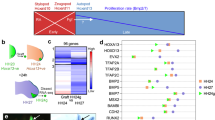Summary
Two retinoids, all-trans-retinoic acid and a synthetic analog, TTNPB, were locally applied to different positions along the proximo-distal axis of embryonic chick wing buds using controlled release carriers. Truncations or limbs with duplicated structures across the antero-posterior axis develop after retinoid application to distal positions in buds from stage 20–24 embryos. Phocomelic limbs develop when the retinoids are applied more proximally to buds of stage 23–24 embryos. Duplications of the pattern of structures along the proximo-distal axis never occur.
Using TTNPB that is relatively stable, the amount of retinoid in the wing tissue when phocomelia is induced was measured. There is twice as much retinoid per cell in the proximal half of the bud as in the distal half of the bud. The concentration of TTNPB in proximal tissue is estimated to be three times higher than in distal tissue in which pattern formation and cartilage morphogenesis are relatively normal.
At early stages in the development of phocomelia, the shape of the bud changes and the indentation that marks the elbow does not arise. Neither retinoid-induced cell killing nor effects on the pattern of programmed cell death were detected.
The induction of phocomelia by retinoids appears to be based on effects on proximal cells, whereas retinoids produce pattern changes by acting on distal cells. Furthermore, compared with pattern changes, higher concentrations of retinoid in the bud tissue are required to produce phocomelia.
Similar content being viewed by others
References
Craig FM, Bentley G, Archer CW (1987) Spatial and temporal pattern of collagens I and II and keratan sulphate in developing chick metatarso-phalangeal joint. Development 99:383–391
Eichele G, Tickle C, Alberts BM (1985) Studies on the mechanism of retinoid-induced pattern duplications in the early chick limb bud: temporal and spatial aspects. J Cell Biol 101:1913–1920
Fekete DM, Brockes JP (1987) A monoclonal antibody detects a difference in the cellular composition of developing and regenerating limbs of newts. Development 99:589–602
Hassell JR, Pennypacker JP, Lewis CA (1978) Chondrogenesis and cell proliferation in limb bud cell cultures treated with cytosine arabinoside and vitamin A. Exp Cell Res 112:409–417
Jelinek R, Kistler A (1981) Effect of retinoic acid upon chick morphogenetic systems. I. The embryotoxicity dose range. Teratology 23:191–195
Kintner CR, Brockes JP (1985) Monoclonal antibodies to cells of a regenerating limb. J Embryol exp Morph 89:37–55
Kochhar DM (1977) Cellular basis of congenital limb deformity induced in mice by vitamin A. In: Bergsma D, Lenz W (eds) Morphogenesis and malformation of the limb. A R Liss, New York, pp 111–154
Kochhar DM, Agnish ND (1977) “Chemical Surgery” as an approach to study morphogenetic events in embryonic mouse limb. Dev Biol 61:388–394
Lee J, Tickle C (1985) Retinoic acid and pattern formation in the developing chick wing: SEM and quantitative studies of the early effects on the apical ectodermal ridge and bud outgrowth. J Embryol Exp Morphol 90:139–169
Loeliger P, Bollag W, Mayer H (1980) Arotinoids: a new class of highly active retinoids. Eur J Med Biochem Biophys Acta 605:33–91
Maden M (1982) Vitamin A and pattern formation in the regenerating limb. Nature 295:672–675
Maden M (1983) The effect of vitamin A on the regenerating axolotl limb. J Embryol Exp Morphol 77:273–295
Saunders JW (1948) The proximo-distal sequence of origin of the parts of the chick wing and the role of the ectoderm. J Exp Zool 108:363–324
Saunders JW, Gasseling MT (1968) Ectoderrnal-mesenchymal interactions in the origins of limb symmetry. In: Fleischmajer R, Billingham RE (eds) Epithelial-mesenchymal interactions. Williams and Wilkins, Baltimore, pp 78–97
Saunders JW, Gasseling MT, Saunders LC (1962) Cellular death in morphogenesis of the avian wing. Dev Biol 5:147–178
Scadding SR, Maden M (1986a) Comparison of the effects of vitamin A on limb development and regeneration in the axolotl, Ambystoma mexicanum. J Embryol Exp Morphol 91:19–34
Scadding SR, Maden M (1986b) Comparison of the effects of vitamin A on limb development and regeneration in Xenopus laevis tadpoles. J Embryol Exp Morphol 91:35–53
Solursh M, Meier S (1973) The selective inhibition of mucopolysaccharide synthesis by vitamin A treatment of cultured chick embryo chondrocytes. Calcif Tissue Res 13:131–142
Summerbell D (1974) A quantitative analysis of the effect of excision of the apical ectodermal ridge from the chick limb bud. J Embryol Exp Morphol 32:651–660
Summerbell D (1983) The effect of local application of retinoic acid to the anterior margin of the developing chick limb. JEmbryol Exp Morphol 78:269–289
Summerbell D, Lewis JH, Wolpert L (1973) Positional information in chick limb morphogenesis. Nature 244:492–496
Thaller C, Eichele G (1987) Identification and spatial distribution of retinoids in the developing chick limb bud. Nature 327:625–628
Thoms SD, Stocum DL (1984) Retinoic acid induced pattern duplication in regenerating urodele limbs. Dev Biol 103:319–328
Tickle C, Alberts BM, Wolpert L, Lee J (1982) Local application of retinoic acid to the anterior margin of the limb bud mimics the action of the polarizing region. Nature 296:564–566
Tickle C, Lee J, Eichele G (1985) A quantitative analysis of the effect of all-trans-retinoic acid on the pattern of chick wing development. Dev Biol 109:82–95
Tickle C, Summerbell D, Wolpert L (1975) Positional signalling and specification of digits in chick limb morphogenesis. Nature 254:199–202
Wolpert L, Tickle C, Sampford M (1979) The effect of cell killing by X-irradiation on pattern formation in the chick limb. J Embryol Exp Morphol 50:175–198
Zimmerman B, Tsambos D (1985) Evaluation of the sensitive step of inhibition of chondrogenesis by retinoids in limb mesenchymal cells in vitro. Cell Differ 17:95–105
Author information
Authors and Affiliations
Rights and permissions
About this article
Cite this article
Tickle, C., Crawley, A. The effects of local application of retinoids to different positions along the proximo-distal axis of embryonic chick wings. Roux's Arch Dev Biol 197, 27–36 (1988). https://doi.org/10.1007/BF00376038
Received:
Accepted:
Issue Date:
DOI: https://doi.org/10.1007/BF00376038




